Bernard Jean Bettelheim
Medical Missionary on Okinawa
April 1846 to July 1854
Dr. Bettelheim's Residence from the Sea
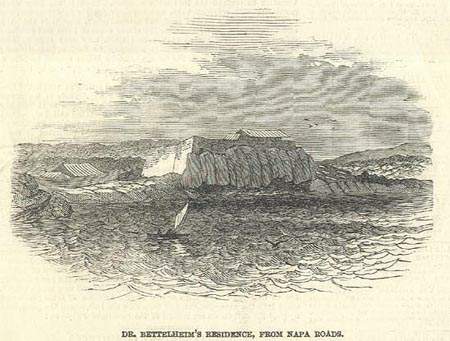
Illustrated London News, March 8, 1851 (Footnote 3)
When Commodore Perry arrived off Naha in May of 1853 he was well aware of Bernard J. Bettelheim (1811-1870) who he described in this way:
Everyone who has known anything of the Lew Chew Islands of late, has heard of a Mr. Bettelheim, a English missionary, who with his family has resided seven years in the mist of the singular people inhabiting Great Lew Chew, and in direct opposition to their wishes. (Perry's Personal Journal, page 61)
As Perry's ships entered the Naha Harbor, Bettelheim raised the British ensign in salute from his residence which was on a point just north of Naha and across from Capstan Rock at Abbey Point/Head (an area now called Sakibaru Saki - the actual rock was razed when Naha Airport was built) at the entrance of Naha Harbor. Within a few hours of anchoring, Bettelheim went aboard to meet Commodore Perry. Through his understanding of the language and culture, he was uniquely qualified to present the Ryukyuan position on various matters to the Americans. Despite his disfavor by the local government, Perry was determined to use Dr. Bettelheim to serve US interests and he did just that. Bettelheim was helpful to Perry as an advisor, representative and commercial type agent. His knowledge of the language, customs and commercial practices made a significant contribution to the expedition. Some have contended that Bettelheim accompanied Perry to Japan but I can find no record of that in the official or unofficial records of the expedition. There is evidence that Bettelheim sought to join the expedition but his request was declined. Bettelheim believed that the rejection was caused by the official interpreter, S. Wells Williams, who had joined the expedition in China. I am confident that his role was strictly limited to assisting on Okinawa proper.
The Bettelheim residence is depicted in the Narrative of the Expedition (shown below). The residence was on the grounds of the Buddhist temple (Gokoku-ji) in Nami-no-ue.
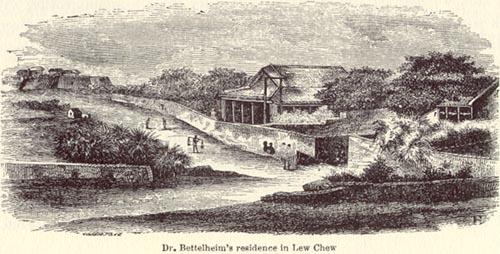
Narrative page 161
A few years before the Perry Expedition, Dr. Bettelheim was visited in 1850 by George Smith, the Bishop of Victoria (Hong Kong). The frontispiece to Bishop Smith's book contained the below picture of the Bettelheim residence.

Lew Chew and the Lew Chewans (Footnote 1), George Smith, 1853
A photograph of the Bettelheim Residence from a 1908 book (Footnote 2) by Henry B. Schwartz.
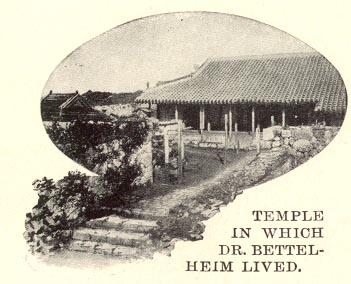
Bettelheim arrived in Okinawa from Hong Kong on April 30, 1846. He was brought by a British commercial schooner the Starling under command of Captain McCheyne. The Starling was diverted, at a very high price, from it's regular route of Hong Kong to Formosa just to deliver the Bettelheim party. Disembarking on Okinawa were Dr. Bernard Jean Bettelheim, his wife, Elizabeth M., their infant daughter, Rose (born 1844), their infant son, Bernard James (born Nov, 1845), a Miss Jane, a tutor - "infant schoolmistress" and Liu Yu-Kan a Cantonese to serve as a translator. While on Okinawa, a second daughter was born on December 8, 1848. She was named Lucy Fanny Loochoo and carries the distinction of being the first European to be born on Okinawa. Liu Yu-Kan, Bettelheim's interpreter, left Okinawa in March of 1849 after conflict developed between the two and he began working with Okinawa authorities against Bettelheim's interests.
The Lew Chew authorities were most unhappy with the Bettelheim presence on Okinawa and openly and in writing expressed that to Commodore Perry in these terms:
* From the authorities of Lew Chew to Commodore Perry:
A prepared statement. Sho Fu-fing, general superintendent of affairs in the kingdom of Lew Chew, and Ba Rio-si, treasurer at Shui, earnestly beg your excellency's kind consideration of some circumstances; and that, to show compassion on our little country, you will take away back to their own land Bettelheim and Moreton, who have remained here long. * * *
In the years 1844 and 1846 some French officers came, and the Englishman Bettelheim also brought hither his wife and children to reside, and they all required something to be daily given them, to our continual annoyance and trouble. Whenever an English or French ship came in, we earnestly represented these circumstances to them, and besought them to take these people away with them. The Frenchmen, knowing our distresses, went away in the year 1848 to their own country, and have not hitherto returned; but Bettelheim has loitered away years here and not gone, and now, further, has brought Moreton with his family to take his place and live here, greatly to the discomfort of the people, and distress and inconvenience of the country.
We have learned that your excellency has authority over all the East Indian, China, and Japan seas, and not a ship of any western country can go from one of these seas to the other but you know and regulate-its movements. Wherefore we lay before you our sad condition in all its particulars, humbly beseeching your kind regard upon it, and requesting that, when your fine ships return, you will take both Bettelheim and Moreton away with you. This will solace and raise us up from our low condition, and oblige us in a way not easy to be expressed. We wish your life may be prolonged to a thousand autumns, in the enjoyment of the highest felicity.
JULY 10, 1854. (Page 498, Volume 1, Narrative of the Expedition to Japan and the China Seas, 1852-4)
Bettelheim translated portions of the New Testament and these were published in Hong Kong under the title Ryukyu-Yaku Fukuinsho (Ryukyuan Translation of the Gospel) in 1852 and 1855.
Much to the relief of the Lew Chewan government, Mrs. Bettelheim and children departed Okinawa on the Supply in February of 1854 and he departed on the Powhatan in July of 1854. Dr. Bettelheim intended to return to England but eventually ended up in New York. After a few years he relocated his family to a farm Illinois. From August to December, 1863, he served as a surgeon in the 106th Regiment, Illinois Volunteer Infantry. After the Civil War he relocated to Odell, Illinois and operated a drugstore and gave lectures about Okinawa and Japan. Later, the Bettelheims moved to Brookfield, Missouri. Dr. Bettelheim died February 9, 1870 at age 59 and is buried with his wife in Brookfield, Missouri.
In May of 1926 a memorial to honor Dr. Bettelheim was unveiled on the grounds of his former residence on Okinawa at the Gokoku-ji Buddhist Temple. The memorial and the activities associated with the unveiling are discussed in the May 25, 1926 issue of the Japan Advertiser, Tokyo.
To see that newspaper article, click here.
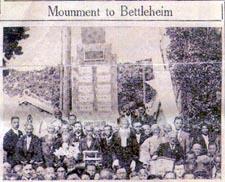
Probably the most comprehensive study of Dr. Betteheims stay on Okinawa is a doctoral thesis by Yoshihiko Teruya titled Bernard J. Bettelheim and Okinawa: A Study of the First Protestant Missionary to the Island Kingdom, 1846-1854. For more information on the thesis, click here.
An interesting publication regarding Dr. Bettelheim on Okinawa is this article: Commodore Perry at Okinawa, From an Unpublished Diary of a British Missionary, The American Historical Review, Vol LI, No 2, January, 1946, pages 262-78 (15 pp). The article contains Dr. Bettelheim's diary as it pertains to the Perry Expedition on the Okinawa visits. For more information on the article, click here. It is in this diary that Dr. Bettelheim notes that the Regent had presented Commodore Perry "...with one of the bells in my residence." This is the bell that ended up at the US Naval Academy.
A book (play) prominently features the Bettelheims and their role on Okinawa during the Perry Expedition. This 1976 book is by I. H. Rubenstein and it is titled, Okinawa Naval Mission. For more information on this book, click here.
A detailed discussion of Dr. Bettelheim's mission on Okinawa is presented in
Cross and the Floating Dragon: The Gospel in Ryukyu by Edward E. Bollinger. For more information on that book, click here.
In 2005 and 2012 two important books were published which provide unique insight into Dr. Bettelheim's stay on Okinawa. Information of these two books is below.
2005 - Bettelheim Journal and Correspondence (1845-1851, Part I) edited by A.P. Jenkins
Available - Purchase Here
Jenkins, A.P. (Editor):
The Journal and Official Correspondence of Bernard Jean Bettelheim, 1845-1854, Part I (1845-51), Okinawa, Japan, published by the Okinawa Prefectural Board of Education, a part of the Okinawa Prefectural History Series, Shiryo-hen 21, Kinsei 2 (edited documents series no.21), 2005, printed by Ozato Insatsu Yogengaisha, 8vo, green cloth with gilt lettering on spine in English and Japanese, ribbon page marker, cardboard slip case, issued without dust jacket, black and white frontispiece, introduction in English (v-xxii) and Japanese (xiv-xxvi), text in English, index, one page errata & addenda sheet inserted loose, xxx, 640 pp. The frontispiece is a sample page from Bettelheim's diary. Through records at Birmingham University and the University of Ryukyus, the editor has assembled an almost complete record of Dr. Bettelheim's journals and official correspondence during the from late 1845 through July 1854. This part deals with this material from December 27, 1845 through December 31, 1851. A subsequent volume is anticipated to bring the record up to 1854. Heretofore only small and selected portions of Bettelheim's journals and writings were published by the Ryukyu (Loochoo) Naval Mission (here) and in the American Historical Review (here). Without a doubt this book represents the most comprehensive publication of Dr. Bettelheim's writings (journals and letters) todate. Professor Jenkins provides extensive footnotes which are an invaluable supplement to understanding writings. This volume covers the period prior to arrival of the Perry Expedition to Japan in Okinawa in 1853. To see the covers, spine of the slip case and title page click here.
2012 - Bettelheim Journal and Correspondence (1852-1854, Part II) edited by A.P. Jenkins
Available - Purchase Here
Jenkins, A.P. (Editor):
The Journal and Official Correspondence of Bernard Jean Bettelheim, 1845-1854, Part II (1852-4), Okinawa, Japan, published by the Okinawa Prefectural Board of Education, a part of the Okinawa Prefectural History Series, Shiryo-hen 22, Kinsei 3 (edited documents series no.22), printed by Ikemiya Shouten, 2012, 8vo, green cloth with gilt lettering on spine in English and Japanese, ribbon page marker, cardboard slip case, issued without dust jacket, black and white frontispiece map behind the title page, introduction in Japanese (i-ii), preliminary information (iii-x) text in Japanese and English, journal, correspondence and balance of the book in English, comprehensive index (pages 709-732), 732 pp. The editor has assembled Dr. Bettelheim's diary and correspondence during the period from January 1, 1852 through July 16, 1854. Dr. Bettelheim's interaction with the American Expedition to Japan starts on May 26, 1853 (page 397) and carries through to the last entry of July 16, 1854 (ending on page 678). In his May 26 entry Dr. Bettelheim reports "Ships in sight" and immediately rows out to meet the American ships of the Japan expedition. The last entry of July 16, 1854 has him aboard the Powhattan and Mississippi as he prepares to depart from Okinawa. Dr. Bettelheim's interaction with the Americans and the Loochooan officials is presented in candid and wonderful detail through his first hand records. To see the covers, spine of the slip case, title page and colophon, click here. ISBN: 978-4-87180-024-2
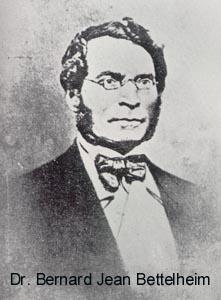 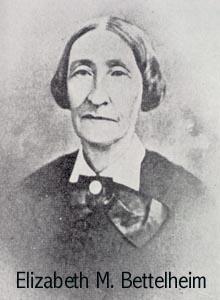
Footnote 1
Smith, George:
Lewchew and the Lewchewans; Being a Narrative of a Visit to Lewchew or Loo Choo, in October, 1850, London, Hatchard, 1853, 12mo (4 1/2 x 7 in - 11.6 x 17.7 cm), black and white engraved frontispiece showing the "Residence of Dr. Bettelheim, Loo Choo," 95 pp. George Smith, D.D. was the Lord Bishop of Victoria (Hong Kong). Probably the most comprehensive English language account relating to Okinawa published prior to the narrative of American Expedition to Japan headed by Commodore Perry which arrived in Okinawa more than two years after Smith's visit. This book is Bishop Smith's account of his efforts, supported by the British Government, to obtain better treatment of Dr. Bernard Bettelheim. Bettelheim, a medical missionary, had been sent to Okinawa in 1846 by the British Loochoo Missionary Society. His presence on Okinawa was unwelcome by the authorities and his activities were constantly limited and hindered. Both Bettelheim and the Okinawan authorities complained about his situation but an impasse had developed. Neither side appeared to be willing to give in. Bishop Smith's visit was intended to show the Okinawans that the full authority and power of the English government supported Bettelheim's continued and unrestricted presence on Okinawa. Bishop Smith's account of his visit, which spanned the period from Oct 3 - Oct 10, 1853, provides exceptional insight into the conditions under which Bettelheim conducted his medical mission. It is an important account of Okinawa as it stood positioned at the leading edge of the relentless push by the Western powers to force Japan to open to outside trade and contacts. In addition to describing Dr. Bettelheim's mission, Bishop Smith provides insight into the geography, culture and political structure he found. This book is often found bound with the Seventh Report of the Loochoo Mission Society which was published the same year. The consolidated book I have examined has dark blue blind stamped cloth covers with the title "Loo Choo Mission." in gilt on the front board.
Footnote 2
Schwartz, Henry B.:
In Togo's Country, Some Studies in Satsuma and Other Little Know Parts of Japan, Cincinnati - Jennings and Graham, New York - Eaton and Mains, 1908, 233 pp, 15 full plate black and white photographic illustrations and 25 smaller black and white photographic illustrations merged into the text. For more information on this book, click here.
Footnote 3
Unstated Author:
Sketches in Loo Choo published in The Illustrated London News, March 8, 1851, London, folio, 1/2+ page, at page 187. This article discusses the visit of HM Sloop Reynard to Okinawa in October of 1850. The purpose of the visit was to show British support for Dr. Bettelheim's missionary efforts on Okinawa and ameliorate the harsh conditions imposed upon him by the local authorities. Bishop George Smith (Bishop of Victoria/Hong Kong) and Captain Cracroft where the principals in this visit. This article brings Bettelheim's mission on Okinawa and the adversities he faced to the public attention in England. It also provides comment on life and culture on Okinawa. The article contains four woodcut engravings relating to Okinawa (1. Dr. Bettelheim's Residence, Loo Choo, 2. Dr. Bettelheim' Residence, form Napa Roads, 3. Mode of Travelling in Loo Choo and 4. Shuidi, the Capital of Loo Choo). In the article Dr. Bettelheim is described as a person who, while "...overflowing with missionary zeal, is somewhat peculiar in his views and conduct." To see the entire article, click here.
The Loochoo Naval Mission and
the Uninvited (Unwelcomed)
"Guest" Missionaries
The Loochoo Naval Mission (1843-1861). The Loochoo Naval Mission was founded in February 1843 by a group of British naval officers. The early force behind the effort was Herbert John Clifford, a British Navy Lieutenant who visited Okinawa during the 40 day stay of the Alceste and Lyra in Okinawa during September and October of 1816. The story (up to 1850) of the Loochoo Naval Mission and the dispatch of Dr. Bettelheim is recorded in The Claims of Loochoo on British Liberality, 1850. For information on that book, click here. Dr. Bettelheim was the first missionary/doctor of that mission. He was succeeded by Rev. G. H. Moreton who arrived on Okinawa in February of 1854. Moreton's health failed and he left Okinawa in October of 1855. The Loochoo Naval Mission activities on Okinawa ended. The Society was formally dissolved in 1861. It was not until 1906 that Henry B. Schwartz was appointed a missionary to the islands and he became the first to reside there since the closing of the Loochoo Naval Mission.
Bettelheim's arrival on Okinawa was preceded in 1844 by a Catholic father, Theodore A. Forcade, and his Chinese interpreter. Forcade had been forcibly landed on Okinawa against the will of the government by a French man-of-war. The French (Rear Admiral Cecille) believed that with Forcade on Okinawa learning the language and ways, their ultimate goal of opening trade with Japan would be facilitated. Forcade was basically restricted to a Buddhist temple called Seigen-ji. Forcade was succeed in 1846 by other Catholic fathers (LeTurdu and Mathieu Adnet) who were also landed by a French man-of-war. The role of the French and British missionaries was the subject of extensive discussion with the Lord of Satsuma through his representative in Kagoshima. Essentially the Japanese reaffirmed the anti-Christianity policy and the presence of both missions was a constant worry for the Ryukyuan authorities. A letter by Father Forcade dated October 12, 1845 was published in Catholic mission records in 1846.
Their presence required constant guard to ensure the enforcement of the anti-Christianity policy of Japan. Every measure was taken, short of deprivation of necessities but including physical assaults, to make life uncomfortable for the unwanted "guests" and render missionary activities impossible. The French missionaries clearly had the force of their country's military might behind them and Bettelheim did not, at least not until late 1850. Because of this, the restrictions on the French were somewhat less than Bettelheim faced. Father Adnet died on Okinawa on July 1, 1848. Father LeTurdu was picked up by a French corvette on August 27, 1848. This left the Bettelheims the only Westerners on Okinawa when Perry arrived in May of 1853. In February 1854 another missionary, E. H. Moreton, and his family dispatched by the Loochoo Naval Mission joined Bettelheim on Okinawa. Now the Ryukyuan authorities had to petition Commodore Perry to take both missionaries away.
An interesting aspect of the French and British presence is the role that the Chinese played. In late 1846 an official Ryukyuan mission was sent to Fukien, China - with approval of Japanese officials - to request that country exercise it's diplomatic influence to bring about the removal of the French fathers and the Bettelheims. Negotiations were conducted in Canton between the Chinese and the British and the French. Both countries refused to give in to the Chinese request that the foreigners be removed. By the end of 1849 these diplomatic efforts were stopped by the Chinese and they advised the Ryukyuans they could do no more and the best policy was for them to make life so uncomfortable for the unwanted guests that they would voluntarily depart. The unusual aspect of this diplomatic dance was the fact that the Chinese served as the diplomatic middle men. These diplomatic efforts were renewed in late 1852 but the British again told the Chinese they would not remove Bettelheim. All these rejections were subsequently overcome by the events unfolding as the American Expedition under Commodore Perry arrived in Okinawa in mid-1853.
The Ryukyuan government made many efforts to have foreign vessels take the "guests" away but with no success. An example of these efforts is recorded by Alfred Laurence Halloran in Woe Yang Jin: Eight Months' Journal Kept on Board H.M. Sloops of War During Visits to Loochoo, Japan and Pootoo. This book relates an account of the rescue of shipwrecked British sailors. The British Bark Elizabeth and Henry was shipwrecked off Kume-jima on February 10, 1849. British officials in Shanghai dispatched HMS Mariner to retrieve the sailors and it arrived in Okinawa on March 2. The book recounts the unsuccessful efforts by Ryukyuan authorities to have the Bettelheims removed from Okinawa with the sailors.
Actually, it was a rare instance where a Western ship called in Okinawa and the Captain was not officially or unofficially requested to remove the Bettelheims. An example is found in the visit of the US Sloop Preble to Naha in 1849. The unsuccessful Ryukyuan request is recorded in a report titled Cruise of the U.S. Sloop-of-War Preble, Commander James Glynn, to Napa and Nagasaki, as recorded in U.S. Senate Documents: 32nd Congress, 1st Session (1851-2).
By late 1849 British authorities were convinced by the Loochoo Mission Society that Bettelheim's presence in Okinawa was in that country's interest and this should be conveyed to authorities in Okinawa. To this end the British dispatched the H.M.S Reynard from Hong Kong to call in Okinawa and convey the British support for the Bettelheim mission there. The mission was headed by Captain P. Cracroft and included George Smith, the Bishop of Hong Kong/Victoria. The British presented a list of grievances to the Okinawans who responded with a request that the Captain remove the Bettelheims. It appears that this official support given to Bettelheim eased the restrictions that were imposed upon him. An account of this visit is recorded by Bishop Smith in Lewchew and the Lewchewans: Being a Narrative of a Visit to Lewchew or Loo Choo, in October, 1850.
The Cracroft mission was followed in Feburary 1852 by a call by the British Ship of War Sphinx. The Captain of the ship, Captain Shadwell, demanded to visit Shuri castle and when this was refused, he marched on the castle with 50 men which included a contingent of 40 armed marines. Captain Shadwell orally requested that the Bettelheims be afforded better treatment and less restrictions be placed on their movements. He also requested that more tolerance be shown to those people interested in Christianity. It is interesting to note that the next year, Commodore Perry also demanded a visit to Shuri castle and when it was refused, he did just the same thing as Captain Shadwell. He marched on the castle with an even greater show of military force.
Perhaps Dr. Bettelheim's most lasting contribution to bettering conditions in Okinawa was his work with smallpox vaccination. Realizing he would need help in introducing the bovine smallpox vaccination in Okinawa, Dr. Bettelheim sought out a widely respected doctor, Kijin Nakachi. The two met secretly and he educated Dr. Nakachi in Western medicine. In 1848 there was a major outbreak of smallpox. Dr. Nakachi was able to find cattle with the pustules needed for obtaining the vaccine and successfully gather and used the vaccine on a limited basis. The activity was not repeated on a large scale until 1851 using vaccine brought by Bishop Smith from Hong Kong in 1850 and instructional pamphlets prepared by Dr. Bettelheim. The stamp below was issued by the Ryukyus government in 1968. It commemorates the 120th anniversary of the first vaccination in the Ryukyu Islands by Dr. Kinjin Nakachi. No credit is given to Dr. Bettelheim.
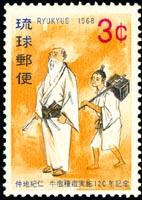
Dr. Kinjin Nakachi & Helper
Scott Number 175
Bettelheim's loyal and long time interpreter, Ichirazichi (aka Shin), served a key role during the visit of Commodore Perry to Okinawa in 1853. In the Narrative of the Expedition he is referred to as the interpreter for the Regent of Okinawa and impressed the American's with his knowledge of English. While he learned much of his English before Bettelheim arrived in Okinawa, no doubt his work with Bettelheim greatly enhanced his skills. While there is not one image of Dr. Bettelheim in the Narrative of the Expedition, Ichirazichi, is featured prominently in a lithograph which is shown below.
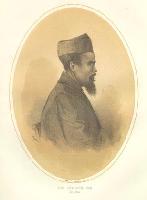
Court Interpreter Shin
Lithograph after Page 192
Narrative of the Perry Expedition to Japan
|








